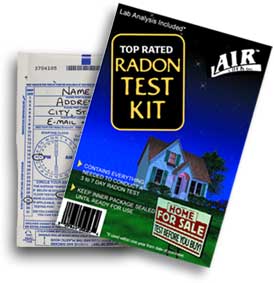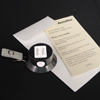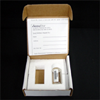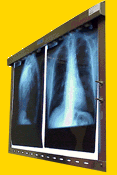How To Test
There are a variety of test kits to choose from and they are extremely accurate so long as you follow the directions that come with each kit. Laboratories that sell the kits are monitored to ensure accuracy and follow very specific guidelines for quality control.
Short Term Test Kits
 If you've never tested your home before, it is recommended that you start with a short-term charcoal test. These tests vary in cost from $10 to $25 each and are placed in your home from 2 to 7 days depending upon the laboratory that manufactures the test kit. Short term test kits are recommended because if your home has a serious radon problem, you'll want to know right away. Testing is easy, just be sure to follow the directions that come with the test kit. Be sure to put the exact beginning and ending times/dates on the kit and mail it back to the laboratory immediately. Results will be mailed or e-mailed directly back to you.
If you've never tested your home before, it is recommended that you start with a short-term charcoal test. These tests vary in cost from $10 to $25 each and are placed in your home from 2 to 7 days depending upon the laboratory that manufactures the test kit. Short term test kits are recommended because if your home has a serious radon problem, you'll want to know right away. Testing is easy, just be sure to follow the directions that come with the test kit. Be sure to put the exact beginning and ending times/dates on the kit and mail it back to the laboratory immediately. Results will be mailed or e-mailed directly back to you.Long Term Test Kits
 For people that want to measure radon over longer periods of time, typically from 3 months to 1 year. These are called alpha track test kits and instead of having charcoal that absorbs the radon, they have a special piece of plastic in them that is perfectly smooth. As radon lands on the plastic it decays and makes little craters that are counted with a microscope. Based on the number of craters (alpha tracks) and the amount of time you exposed the kit, the lab will know how much radon is in your house. Cost varies from $20 to $30 each.
For people that want to measure radon over longer periods of time, typically from 3 months to 1 year. These are called alpha track test kits and instead of having charcoal that absorbs the radon, they have a special piece of plastic in them that is perfectly smooth. As radon lands on the plastic it decays and makes little craters that are counted with a microscope. Based on the number of craters (alpha tracks) and the amount of time you exposed the kit, the lab will know how much radon is in your house. Cost varies from $20 to $30 each.Radon In Water Test Kits
 Testing your water is not usually needed unless your home uses water from a well for drinking, showering and cleaning. City and rural water supplies regulate radon concentrations to make sure that if you have a radon problem, it's coming from the soil, not your tap. Radon in water test kits vary in cost from $25 to $40.
Testing your water is not usually needed unless your home uses water from a well for drinking, showering and cleaning. City and rural water supplies regulate radon concentrations to make sure that if you have a radon problem, it's coming from the soil, not your tap. Radon in water test kits vary in cost from $25 to $40.Test kits are available on this site or from most hardware and home improvement stores. All the test kits available today are monitored by the EPA for accuracy and provide results directly to you. Some test kits do not include the cost for laboratory analysis so the actual price might cost twice as much when you're done. That's o.k. so long as you know what the analysis fee is before buying the test kit. Only one test kit is needed unless the lowest level of your home is extremely large and greater than 1,500 square feet.
Where Do I Test?
Test in the basement if you have one. Radon tends to spread throughout the entire house, especially if your furnace/air conditioning unit is located in the basement but testing in the basement is always preferred. Select a location in the center of the most used room, about 3 feet off the floor, (breathing zone while sitting), away from vents, fans and outside walls.
If you don't have a basement, test in the lowest livable area of the home. For homes with crawlspaces or homes with the floors in direct contact with the ground, test on the first floor, in the center of the most used room, about 3 feet off the floor, away from vents, fans and outside walls. Always test on the lowest livable area of the home whether you spend any time there or not.
What Do The Results Mean?
 As you already know, radon is radiation so you want to be exposed to as little of it as possible. Radon in outside air varies from 0.2 to 1.0 pCi/L. The average house in America is 1.3 to 1.5 pCi/L. The World Health Organization reccomends a maximum level of 2.7 pCi/L. The U.S. Environmental Protection Agency states that, "If your home is above 4.0 pCi/L, fix it. If your home is between 2.0 and 3.9 pCi/L, seriously consider fixing it." Remember that 4 pCi/L is not considered safe, it is considered the maximum level you should have (according to the EPA).
As you already know, radon is radiation so you want to be exposed to as little of it as possible. Radon in outside air varies from 0.2 to 1.0 pCi/L. The average house in America is 1.3 to 1.5 pCi/L. The World Health Organization reccomends a maximum level of 2.7 pCi/L. The U.S. Environmental Protection Agency states that, "If your home is above 4.0 pCi/L, fix it. If your home is between 2.0 and 3.9 pCi/L, seriously consider fixing it." Remember that 4 pCi/L is not considered safe, it is considered the maximum level you should have (according to the EPA).Comparing Apples To Apples
 If you live in a home for 1 year that has exactly 4.0 pCi/L then your radiation exposure is the same as 200 chest x-rays per year. This is based on time exposed so if you are only home half the time, cut the amount of x-rays in half. If your radon level is twice that amount, then double the number of x-rays.
If you live in a home for 1 year that has exactly 4.0 pCi/L then your radiation exposure is the same as 200 chest x-rays per year. This is based on time exposed so if you are only home half the time, cut the amount of x-rays in half. If your radon level is twice that amount, then double the number of x-rays.  The Nuclear Regulatory Commission requires all nuclear power plants to put fences around each facility at a distance far enough away so that a person standing at the fence line will not receive any more radiation than 25 mRem. They use the same formula for around nuclear waste sites. That's a lot of "ticks" on a Geiger counter and a house with 4 pCi/L is worse than that! Just because you can't see the radiation doesn't mean it's not there.
The Nuclear Regulatory Commission requires all nuclear power plants to put fences around each facility at a distance far enough away so that a person standing at the fence line will not receive any more radiation than 25 mRem. They use the same formula for around nuclear waste sites. That's a lot of "ticks" on a Geiger counter and a house with 4 pCi/L is worse than that! Just because you can't see the radiation doesn't mean it's not there.X-ray technicians wear lead aprons and stand as far away as possible. Take the same approach by either reducing the amount of radon in your home or stay away from home as much as possible. It's usually much easier just to have the radon problem fixed.
Buying A Home?
 If you're buying a home, be sure to have it tested as part of the inspection process. You'll want to hire a certified radon specialist that uses a Continuous Radon Monitor or Electronic Radon Monitor instead of the kits mentioned above. These monitors provide hour to hour readings to detect tampering and insure that all required testing conditions are met. If you find a real estate agent that cares enough about you and your family to recommend a radon test, you've found a true professional, a real gem and worth recommending to everyone you know.
If you're buying a home, be sure to have it tested as part of the inspection process. You'll want to hire a certified radon specialist that uses a Continuous Radon Monitor or Electronic Radon Monitor instead of the kits mentioned above. These monitors provide hour to hour readings to detect tampering and insure that all required testing conditions are met. If you find a real estate agent that cares enough about you and your family to recommend a radon test, you've found a true professional, a real gem and worth recommending to everyone you know.If you're not buying a home, use the kits instead. They are just as accurate and you're certainly not going to cheat yourself.
Protecting Your Family Is Easy... Learn the Facts, Test your Home.
If a Problem is Found, Fix It.
This site is made possible by visitors like you.
Thank you and we appreciate your support!
This site is made possible by visitors like you.
Thank you and we appreciate your support!
